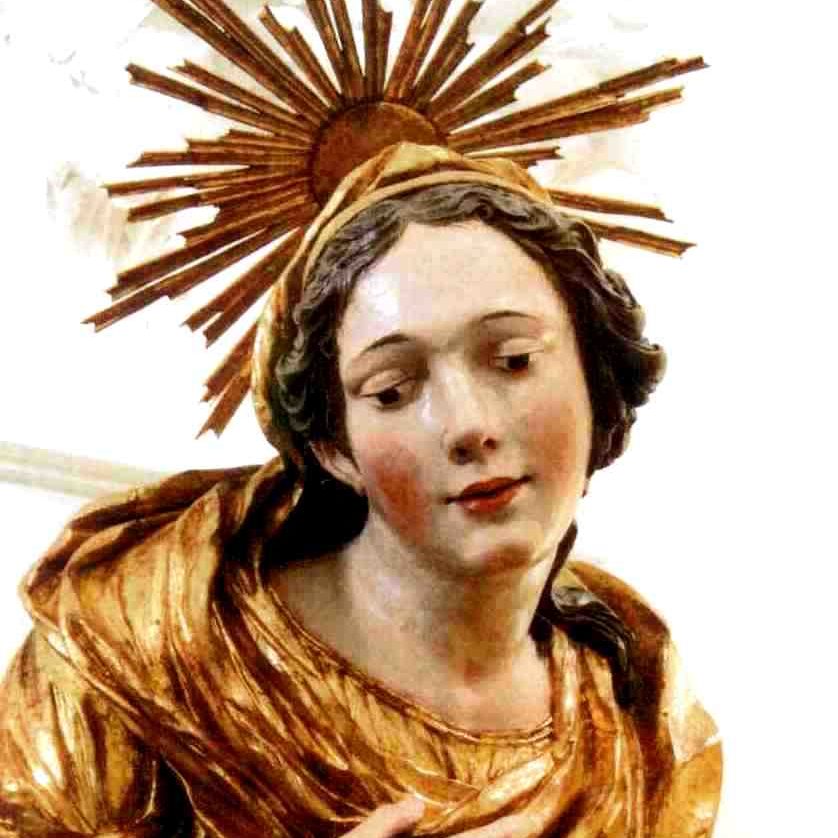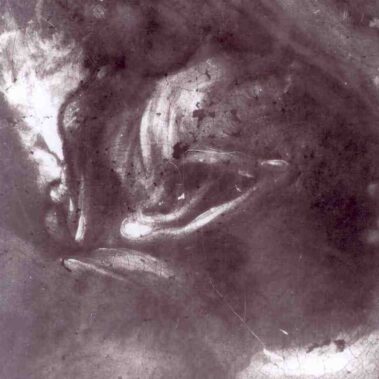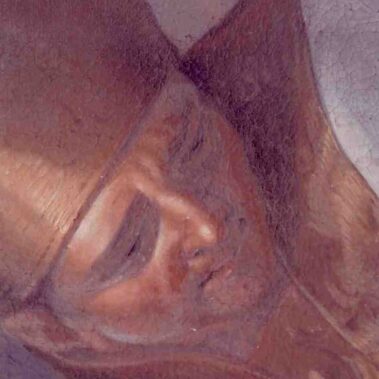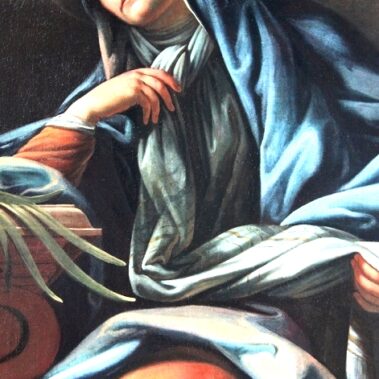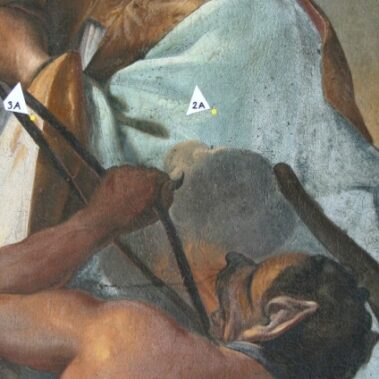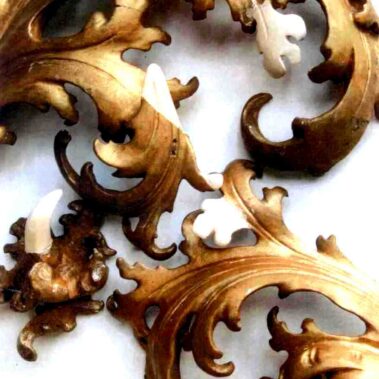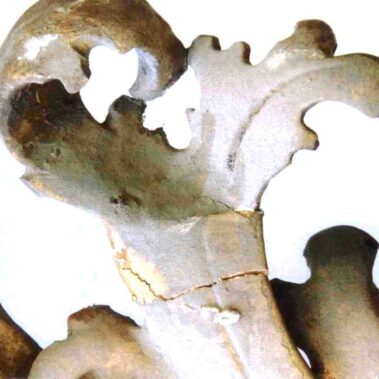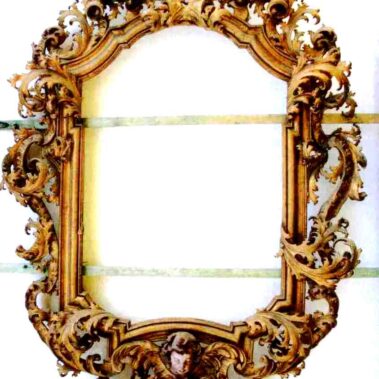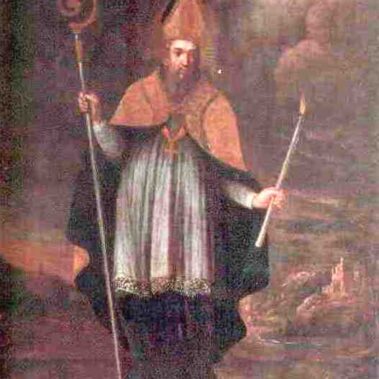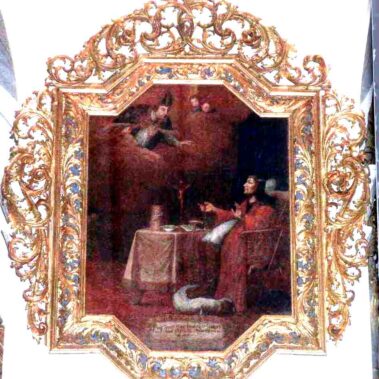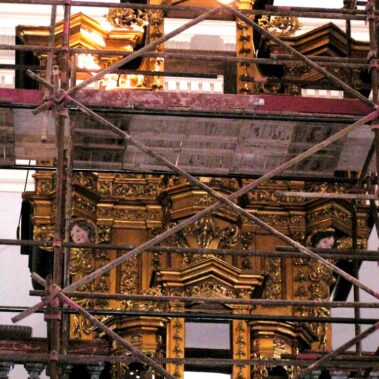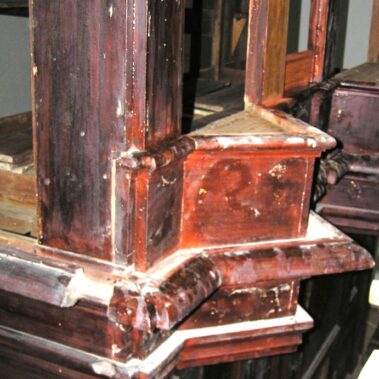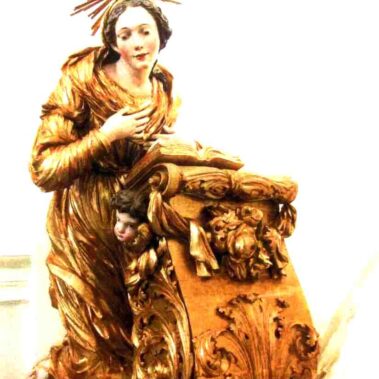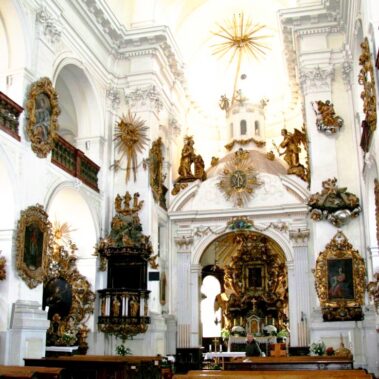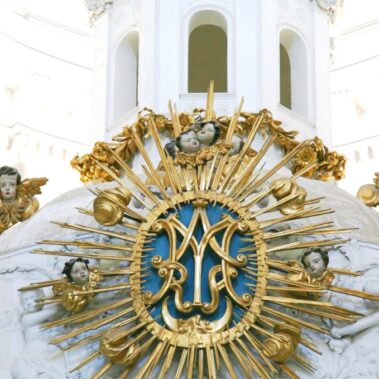Pilgrim Church of the Virgin Mary Help of Christians at Chlumek, Luže, Czech Republic

| Address: | Kostel Panny Marie Pomocnice křesťanů na Chlumku, 538 54 Luže |
|---|---|
| Description of work: | Restoration of the organ case
Restoration of the decorative frames Restoration of the paintings Restoration of the sculpture “Annunciation of the Virgin Mary” |
| Investor: | Roman-catholic parish of Luže |
| Contractor: | GEMA ART GROUP a.s. |
| Implementation: | 06/2010 – 12/2010 |
The impetus for the foundation of the Church of the Virgin Mary Help of Christians at Chlumek in Luže came from the Countess Marie Maxmiliána of Žďár, wife of Jindřich Vilém Slavata of Chlum and Košumberk, who gained his place in the history books as one of the victims of defenestration at Prague Castle in 1618. Soon after their wedding the Countess of Žďár settled at her husband’s castle of Košumberk not far from the town of Luže. Like Vilém Slavata, Marie Maxmiliána came from a traditionally Catholic background. She kept a precious copy of the’ miracle’ painting of “The Virgin Mary of Pasov” at the Košumberk castle and was looking to build a suitable shrine for it. The construction of the church in its original form was started in 1668 in the presence of the Bishop of Hradec Králové. Before long the church was too small for all the pilgrims arriving in Luže with votive offerings for the ‘miracle’ picture and in 1690 extensive rebuilding of the church began; it was finished after various delays six years later. The Countess of Žďár did not live to see the completion of her church. Clerical administration of the church was taken over by the Jesuit Order, who initially arrived at the Košumberk estate at the request of the Countess Marie Maxmiliána. The early Baroque building has a single nave with six chapels; the main façade is dominated by two square towers, each covered by an onion-shape dome with a lantern. The plan for the church was designed by the architect Pavel Ignác Bayer and was later followed by the Italian architect Giovanni Battista Alliprandi, who took over the building of the church. The interior of the church is richly decorated; particularly attractive is the main altar located under an internal brick rotunda with a cupola by I. Bayer. The entire rotunda is decorated by angels and floral motifs, probably the work of the sculptor Jiří František Pacák. The valuable painting “The Virgin Mary of Pasov”, a copy of the Renaissance original by Lucas Cranach the Elder from 1514, is located here. Copies of this pictures were not rare in Central Europe at that time, as the pilgrims had a great belief in the miraculous powers of the depicted Virgin Mary. Apart from the main altar the church has six further altars dedicated to St Barbara, St Anna, St Ignatius of Loyola, St Francis Xaverius, St Apollonia and St John Nepomuk. The author of the altar paintings of the saints is Jan Jiří Heinsch, who worked on them between 1705 and 1706. From the same time comes Heinsch’s painting “The Virgin Mary Our Lady of Sorrows” on the chancel arch. Within the interior of the church are four further paintings of Czech patron saints by an unknown artist dated approximately to the year 1700. The extensive sculptural and carved ornamentation of the interior is the work of František Baugut, Maxmilián Brabenec and Jiří František Pacák. Most of the decorative work originates from the end of the 17th and from the 18th century. It was the restoration of this valuable inventory of the church that the GEMA ART GROUP a.s. was responsible for in 2010.
Restoration work concerned the furnishings of the interior of the Church of the Virgin Mary Help of Christians at Chlumek in Luže. A team of experts participated in the rescue of the organ case from 1714, the paintings of St. Ludmila, St Wenceslas, St Prokop, St Adalbert and The Virgin Mary our Lady of Sorrows, the restoration of the carved frames and renovation of the Baroque sculpture Annunciation of the Virgin Mary. All interventions were of a highly professional standard and aimed at minimal disturbance to the art works. All renovations were discussed with representatives of the Heritage Office. The work, under the management of the company GEMA ART GROUP a.s. took place between June and December 2010.
Restoration of the paintings of the Czech patron saints (St Prokop, St Ludmila, St Wenceslas and St Adalbert):
The four paintings of the Czech saints by an unknown artist, dating back to around 1700, are placed at the level of the church’s tribune. All four pictures are painted on a canvas base material, attached to collapsed frames. Because of the lost stretch, the canvas was warped. The paint itself was in an unsatisfactory state and in some places the paint layer was loose and crumbling. Most of the mechanical damage was found at the edges of the canvas. The painting of St Ludmila exhibited signs of more extensive damage. There were occurrences of oxidation of the blue colour on all the paintings. After closer examination evidence was found of former over painting and restoration efforts. The painting of St Wenceslas was the most repaired and its surface was covered by a layer of dust and greasy deposits. Because of a thick layer of yellowed varnish, the colours were severely distorted.
Before any intervention by restorers detailed research was undertaken. X-rays were taken as well as three macro samples from each paintings and an examination under UV light was carried out. In the case of the painting of St Ludmila, infrared reflectography was also employed. After the evaluation of the research the loosened portions of the colour surface were secured so they could not fall off during the handling of the paintings. The colour layer was fixed on the underside by a special solution and a heated palette knife. Following this treatment the canvases could be demounted. Tears in the canvases were repaired using polyamide and a fortifying layer of fibreglass material was attached to their underside. For the paintings of St Ludmila and St Wenceslas a rentoilage of the entire surface was carried out using a special foil and a linen canvas. Layers of yellowed varnish and of any secondary over painting were removed and the front side of the canvas was ironed and covered by a layer of non-woven fabric and a special foil, which will protect the colour layer from any future damage. The paintings were then stretched on a frame, which was previously treated against mould and woodworm. Any defects in the layer of colour were repaired using emulsion sealant. Afterwards, colour retouching using specialist restorer paint was carried out. Finally, the surface of the paintings was covered by a protective layer of varnish containing a UV filter.
Restoration of the painting The Virgin Mary Our Lady Of Sorrows:
The painting The Virgin Mary Our Lady Of Sorrows, located on the chancel arch of the church, is probably the work of the painter Jan Jiří Heinsch from 1705 -1706. Before the work commenced, an X-ray examination took place, macro samples were taken and an examination under UV light and infrared reflectography were carried out. The painting exhibited many signs of damage. The canvas was attached to an unsuitable frame which caused warping. The layer of colour was cracked and in places had fallen off. The visual impact of the painting was disturbed by past interventions, when the canvas was lengthened by approximately 20 centimetres by gluing a canvas strip to both the upper and the lower edge. The seams were visible and in places had become unstuck; the colours did not harmonize with the original part. The edges of the canvas exhibited some mechanical damage, which was not extensive enough to warrant rentoilage. The restoration steps undertaken were almost identical with those of the restoration of the paintings of the Czech saints. The loosened portions of the colour layer were secured and most damaged areas preventatively taped on the front side. The underside was cleaned and the canvas extensions removed, using a special enzyme to dissolve the glue. The colour layer was then fixed to the canvas underlay using a suitable solution and a heated palette knife. The colour surface was rid of any secondary over painting, yellowed varnish and dust deposits. Defects in the colour layer were eliminated by emulsion sealant and the canvas stretched onto a new frame, which was preventatively treated. After colour retouching the surface was covered by a protective layer of varnish.
Restoration of the decorative Acanthus frames:
Restoration concerned four frames made of lime wood dating back to 1705. The frames are decorated in their lower parts by Acanthus arabesques and puttis. The frames bore marks of amateur repairs from the past. The original gilding was in some places repaired using brass, which had darkened over the years. Many areas exhibited signs of mechanical damage such as cracks and missing parts. Some dislodged pieces had been reattached in the past using glazier’s putty or plaster of Paris. The head of each putti was cracked and had other localized damage. The worst of the incompetent previous interventions was the repeated nailing of the loose joints, which caused the breakage of small parts of the Acanthus. The frames were slowly taken apart and cleaned from dust deposits. Gilded surfaces were cleaned with proprietary agents. The loose chalk layer was secured using a hypodermic syringe and a special solution. The brass was removed by solvents. The unsuitable glazier’s putty and plaster of Paris were expertly removed. Loose joints of the frames were fixed and the frames themselves received radiation treatment against woodworm, signs of which were detected. The wood was strengthened and missing and damaged pieces replaced by copies made from lime wood. Smaller defects were in-filled and the gilding was renewed using gold leaf which was colour-harmonized with the older gilded parts. Finally, the surface was treated with Damar varnish.
Restoration of paintings of St Stephen, St Blažej (Giovanni), St Valentine and St Liborius:
Each of the paintings was expertly examined prior to restoration work and then removed from its ornate frame. The paintings exhibited traces of several unprofessional interventions: later retouching had darkened over time and repairs of defects were not carried out correctly. The surface of the paint was cracked in many places. The underside of the canvases had been patched up in the past but the patches had been loosened by the effects of dampness in the church.
As the first step in the restoration of the paintings, the dirt deposits were removed from their surface. Loose layers of colour were injected with a fixative. Unsuitable patching on the underside was removed and the canvas was saturated by a wax/resin emulsion. The paintings of St Stephen and St.Blažej exhibited signs of severe damage to their original canvases and for this reason new canvases were ironed on. The cracking was also sensitively dealt with. Some older sealants were colour retouched. Finally, the surfaces were varnished with a protective conservation varnish, which visually resembles the original varnish of the Baroque era.
Restoration of the decorative frames of the paintings of St Stephen, St Blažej, St Valentine and St Liborius and The Virgin Mary Our Lady of Sorrows:
The carved gilded frames were covered by a thick layer of dirt and many delicate carved details were broken off. Some areas of the frames had been retouched using bronze, which over time became much darker then the gilded parts. During the restoration work the loosened up chalk layer and the gilding were stabilized. The bronze layer was removed after the cleaning and replaced by proper gilding. Missing wooden parts were replaced using lime wood, the material of the originals. More significant cracks were filled with wood inserts and small defects were sealed. Loose parts of the frame were re-glued and strengthened. Finally, poliment gilding was applied using gold leaf ducat double. The surface of the frames was polished with agate burnisher according to Baroque techniques, i.e. relief parts more shiny then the indentations.
Restoration of metal elements in the frame of the painting of The Virgin Mary Our Lady of Sorrows:
Part of the restoration remit was the renovation of the metal elements in the frame of the picture of the Virgin Mary. This copy of the paining by Lucas Cranach the Elder is the most valuable relic within the interior of the Church of the Virgin Mary at Chlumek in Luže.
The restoration of metal elements concerned the crests in the picture, the Gloriole with the inscription MARIA below the painting and the metal parts of the wooden frame. The crests were found to be in a poor state: the silver parts had over time succumbed to corrosion, the gilding was worn. During the restoration the coloured glass imitations of precious stones were also renewed. The glass stones were covered by remnants of cleaning substances and in places missing altogether. Silver parts were first rid of corrosion and then re-polished. During the removal of the blackened layer of the silver, engraved writing was discovered with dates and the signature of the craftsman. Gilded part were also re-polished and missing glass replaced by copies.
The gilded surface of the Gloriole with the inscription MARIA was dirty and blackened. The rays of the Gloriole and the inscription itself were made of copper and gilded. The actual lettering of MARIA exhibited damage where one of the bolts used to secure the inscription had broken off. The missing part of the bolt was replaced and the gilded surface re-polished.
The spruce wood picture frame was also the subject of restoration. The wood is encased in silver foil which is hallmarked and bears the date 1756. The outer part of the frame is decorated with silver and gold. The corners of the frame have gilded wrought copper ornamentation. The components of the ornamentation were partly corroded (silver) and covered in dirt. In the past attempts have been made to renew the shine using French polish. The frame was taken apart and the parts restored. The spruce wood was cleaned and treated against mildew and woodworm. The metal elements were rid of corrosion, re-polished and treated with wax preservative.
Restoration of the organ case and the balustrade:
The organ dates back to 1714 and is the work of J. J. Herman of Chrudim. It measures approximately seven metres. Some repairs were carried out on it during the 19th and at the beginning of the 20th century but not all of them were suitable.
The company GEMA ART GROUP a.s. was responsible for the restoration of the organ case and its four figures of angels and an eagle. Expert restoration research was carried out prior to any intervention. During the research it was established that the current dark brown colour of the case had been applied at a later date and covered the original gilding.
All surfaces of the organ were covered in a layer of dust and pigeon droppings. Parts of the organ case were significantly damaged by holes from the original mounting of some of the sculptures and carvings. Faults were in the past in-filled by a hard, rough putty. Decorative carving on the case was found to be in reasonably good shape but the original gilding was unsuitably covered by a layer of bronze. Parts of the chalk layer had degenerated due to mould, which had caused surface cracking.
The surfaces of the organ case were first rid of the dark brown layer of oil paint using nitrate paint thinner and all old fillers were mechanically removed. Holes left after removal of carvings were in-filled with chalk putty. The new shellac and mixtion surface was metallated. The bronze layer on the carved ornamentation of the organ architecture was removed with ammonia solution, nitrate paint thinner, spirit, vinegar and bread. The missing chalk layer was replaced using Bologna chalk. New gilding was then applied.
The ornamental figures of four angels and an eagle and some of the carvings were dismantled and given a restoration treatment. Cracks were sealed, larger areas filled with inserts and missing parts recreated from lime wood. Several joints in the figures of the angels were strengthened with wooden pegs. During restoration the secondary overpainting of the angels was also removed using ammonia solution, revealing the older polychrome underneath. This original polychrome was retouched with reversible paints and water colour binder with addition of white tempera. To conclude the colour polychrome was treated with beeswax and its surface re-polished.
The wooden balustrade was also renovated during the restoration work. The railing was found to be in good shape and only a few of the balusters showed mechanical damage. The surface was covered by fake marbling which was removed using ammonia solution. The removal of the marbling uncovered distinctive colour polychrome in two shades of blue with dark and white lines. The polychrome was retouched and its surface afterwards treated using beeswax with addition of resin.
Restoration of the sculpture Annunciation of the Virgin Mary:
The statue group, which dates back to 1705, is the work of the sculptor Jiří František Pacák. It is carved from lime wood and consists of the figure of the Virgin Mary and the figure of an angel. The whole surface was prior to restoration covered by dust deposits, lime dust from the wall paint of the church and pigeon droppings which in the upper parts had seriously disturbed the chalk layer. After visual examination the experts found signs of previous unprofessional repairs. The sculptural group had cracks which had been in-filled in the past, but in many places the filler was loose or had fallen out entirely. The lily in the sculpture of the angel was severely damaged and its broken off leaves had only been replaced with tin foil. Broken wooden parts were wrapped up in textile fabric dipped in glue. The most damaged part of the sculpture of the Virgin Mary was the halo, which was badly broken with some missing rays replaced with unsuitable material. The original gilding was cracked. The wood of the sculptures exhibited only localized minor woodworm damage at the back of the sculpture of the angel.
The process of restoration started by securing the loose polychrome woodwork. Subsequently, the secondary over-painting of the gilded parts was removed using a paraffin based solvent. In the carved folds it was necessary to use a stronger solvent – dimethylformamide – and a scalpel. The colour layers were removed from the faces of the sculptures, which resulted in the discovery of the original colouring of the strands of hair around their cheeks and foreheads. The damaged parts of the halo and the lily were rid of the amateur repairs. The metal leaves of the lily were replaced by leaves carved from lime wood. Other missing parts also were replaced by lime wood copies. The degraded putty from the secondary repairs was removed, the cracks cleaned and sealed with a chalk and glue filler. In the case of larger fissures, the sculptures were repaired using wooden inserts. Next, the colour retouching was carried out and gilded surfaces covered by gold leaf. The polychrome was restored using gouache paint. To conclude, the surface of the sculptures was given a protective layer of varnish.
V kostele probíhají pravidelné mše svaté, a to každou neděli v 9:30 hod. Prohlídka památky je možná 30 min. před začátkem bohoslužby.
Více informací naleznete ZDE.






